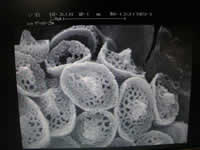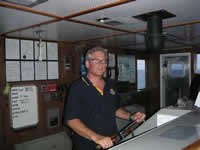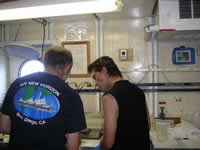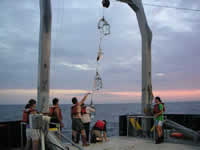


|
The Project Part 1: Part 2: Part 3:
|
01 August, 2005
|
 The CTD just below the surface  A one-celled (!) coccolithophore, “Mexican Sombreros”  Captain of the R/V New Horizon, Murray Stein  Fred and Luis talking shop |
Why are port holes round? They are always circular because they are easier to seal. Corners do not seal well, and on ships, keeping water out of the interior of the ship is essential.
We’re up at 2 am again, casting for more water to put into another array at dawn. Do you remember that an array is an underwater incubator, where the scientists can control a small piece of the natural environment? While we are sending the CTD down, we saw a two-foot long needle fish gorging on juvenile flying fish. It slithered about picking off those fish unfortunate not to have leapt out its way. But there are still hundreds of the little critters, buzzing and jumping, somewhat like a hay field full of frenzied grasshoppers.
At noon, we put the CTD into the water again. One of the sensors wasn’t working properly so Rob and Terri repaired it in about fifteen minutes. It’s still hot today, but the sun and heat aren’t so overwhelming today because there’s a good breeze blowing.
More from The Log from the Sea of Cortez:
We ran from collecting station to new collecting station, and when the night came and the anchor was dropped, a quiet came over the boat and the trip slept. And then we talked and speculated, talked and drank beer. It is very easy to grow tired at collecting; the period of low tide is about all men can endure. At first the rocks are bright and every moving animal makes his mark on the attention. The picture is wide and colored and beautiful. But after an hour and a half the attention centers weary, the colors fade, and the field is likely to narrow to a single individual animal. Here one may observe his own world narrowed down until interest and, with it, observation flicker and go out.
The work of water sampling and filtration becomes routine after a few days. We repeat the process daily: send the CTD down, fill the tubes with seawater, bring it back up on deck, empty the cylinders, and record where it came from. But when the scientists see the data from the CTD casts displayed on the computer, they express wonder and excitement as the profile of the water column appears. Both the scientists and crew exhibit no lack of awe when the dolphins and whales break the surface. Every sighting of marine life is relayed with urgency to everyone awake on ship. We all rush outside, armed with cameras to record the activity. Every night the sunset brings us on deck. Thousands of pictures have been taken, and at the end of the cruise, we will combine them all and make a CD for everyone. The beauty and mystery of the marine world foster a sense of child-like wonder that does not diminish with repeated contact.
To me, the scientists seem to have a profound understanding of the ocean, its processes and life forms. But they consider their collective knowledge to be at a primitive stage. The ocean remains a great frontier. There’s a lot of work to be done out here.
Math Problem:
Sorry, I’m too tired to come up with anything today.
Trivia Tidbit of the Day:
Tuna are very swift swimmers. Some species of tuna can swim as fast as 45 miles (72 kilometers) per hour. Like other fish, a tuna has gills that take oxygen from the water passing over them. But unlike most fish, a tuna cannot pump water over its gills. Therefore, it must swim continuously in order to breathe. Does this mean that a tuna never sleeps? For that matter do any fish sleep? I don’t know.
![]()

